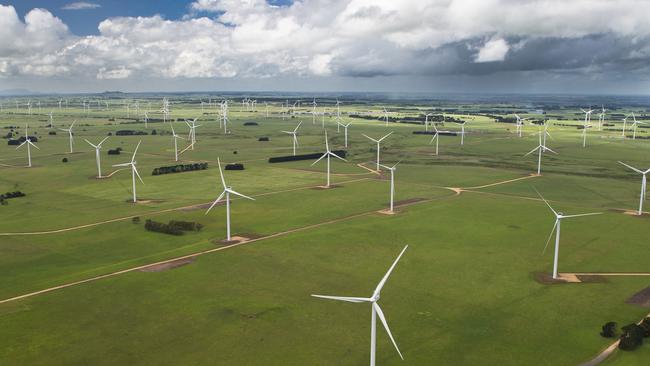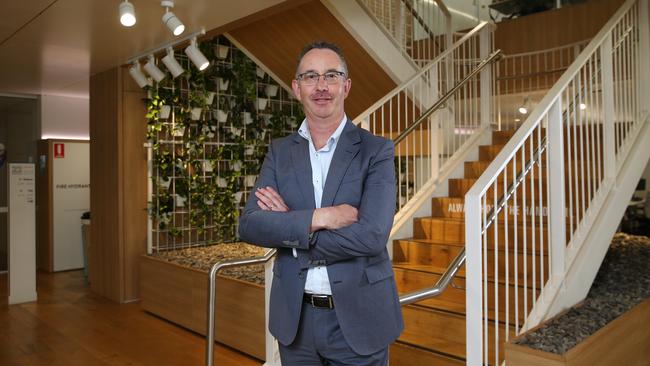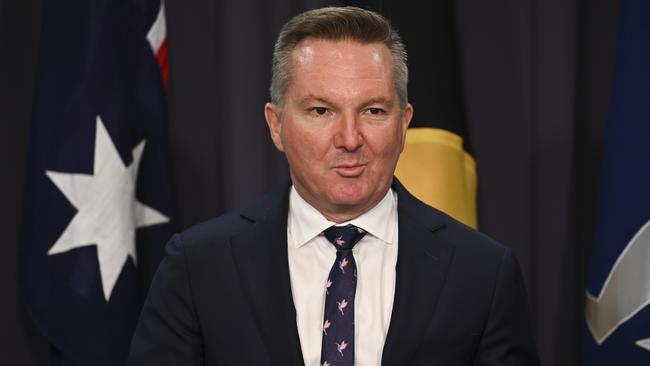Sun shines on AGL as it seeks faster green energy approvals
Power giant AGL has upgraded its annual earnings guidance for the second time in three months and at the same time called for speedier approvals of new projects.

A faster approval processes for new energy projects is needed, AGL chief executive Damien Nicks says.
His comment came as the power giant upgraded its annual earnings guidance for the second time in three months.
Mr Nicks said it was inevitable there would be “bumps in the road” as Australia transitioned from a dependence on coal to more renewable energy, while noting one recent wind farm project had taken five years of planning to proceed.
The AGL boss said the utility was “well under way” with its plans to build 12 gigawatts of new energy and firming capacity over the next 12 years, involving an investment of some $8bn to $10bn.
That would involve using a range of new energy sources, with a big emphasis on pushing forward with new wind projects in particular, he told an energy conference hosted by the Australian British Chamber of Commerce.

“For me it is about how do we make sure we are continuing to deliver into that (move to net zero),” he said.
“Things are picking up pace, not slowing down.”
On the profit front, AGL told the ASX on Tuesday its underlying net profit after tax was likely to come in between $760m and $810m, up from guidance given in February of $680m-$780m.
That in turn had been upgraded from a range of $580m-$780m.
AGL delivered an underlying net profit of $281m in FY23, up 25 per cent on the previous year, and a statutory loss of $1.26bn once impairment charges relating to the early shutdown of its coal fired power stations and the impact of financial instruments were factored in.
AGL shares closed 7.4 per cent higher at $10.01 on Tuesday.
AGL told the ASX that strong demand and better plant availability underpinned the upgrade.
“The update to guidance reflects the continued strong operational and financial performance of the business since the half-year results, due to improved plant availability, flexibility and generation, higher consumer demand over the summer period in NSW and Queensland, and continued strong customer markets performance,’’ the company said.
The company’s underlying EBITDA is expected to come in at between $2.12bn and $2.2bn, up from $2.02bn and $2.17bn previously.
AGL will report its full-year results on August 14.

Mr Nicks’ comments came as federal Energy Minister Chris Bowen strongly defended the community consultation process for new renewable energy projects, arguing that it was resulting in new projects being approved.
He said that by February next year the federal government was prepared to commit to a new emissions reduction target for Australia for 2035 that would be both “ambitious and achievable.”
Mr Bowen rejected suggestions that community consultation processes over new energy projects were a one-way street which did not result in new projects going ahead.
He said the results of the processes were “not as dire as you would think reading some newspapers”.
He said he had recently been to a meeting of some 600 people at the University of Newcastle, with many attendees talking about the need for more renewable energy in the region and strong support for offshore wind projects.
He said it was important to have community consultation processes.
“We need to think about having better, earlier community consultation,” he said.
“There is a mix of very legitimate genuine concerns that we need to work through so people know they are having a safe transition.”
He said some of those involved in the consultation processes were using it to score political points.
This was a “destructive approach” but he said there were “smart people” who knew that change was inevitable.
Mr Bowen said that people in the regions were realistic about the fact that coal-fired power stations were coming to the end of their lives and they were looking at the need for new forms of energy.
He said he had gone through consultation processes for three offshore wind projects he had declared as minister.
“Each of them has had changes from the original but that shows the consultation process is real,” he said.
Mr Bowen said carbon capture and storage had a “role to play” in the energy transition but the government had no plans to encourage its development with subsidies.
He said the government believed that it had “no role to play” in extending the life of the use of coal, but could play a role in “hard to abate” energy sectors.
“The government’s view on carbon capture and storage is very pragmatic,” he said.
“There are some who say that CCS is the answer to our problems and others say it is an evil which should never be contemplated.
“Our approach is that it can and should play a role in hard-to-abate sectors, in particular where it is proven to work and is not simply greenwashing, or driving more exploitation.
“Where it is simply capturing emissions, it has a role to play.”
He said the government saw its role in CCS was “facilitation and regulation” and not making subsidies to encourage the technology.
“It has a role to play,” he said.
“It is not a panacea. It will have no role in coal.
“There is no prospect for carbon capture and storage working for coal-fired power.”
Mr Nicks told the conference that AGL was looking for a range of new energy sources as part of its move to more renewable energy, including solar and wind.
“It’s going to be onshore wind and offshore wind, it’s going to be solar on the rooftop and it’s going to be large scale solar,” he said.
“It’s going to be a whole range of technologies.”
He said AGL was announcing new projects every three or four months as part of its move towards more reliance on renewable energy.
He said the move to more wind generating capacity was an important part of AGL’s plans.
He said that AGL already had access to a “huge amount” of solar power from the roofs of its customers so it was now focusing heavily on wind.
“Wind makes sense for me,” he said.
“It does different things and blows at different times of the day and in different regions.
“When you think about managing your portfolio, you want to make sure you are getting energy at different times of the day,” he said.




To join the conversation, please log in. Don't have an account? Register
Join the conversation, you are commenting as Logout